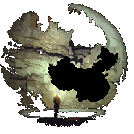
Grottes et karsts de Chine
Sur les traces de Xu Xiake
 Magangdong -
Magangdong -
Détail2/01/2024 12:14:05
Province, Préfecture, District :
Beijing 北京, Beijing , Fangshan 房山区
Latitude Nord - Longitude Est :
39.711342 - 115.745130
Altitude (m) : 751
Développement (m) : 200
Profondeur (m) :
Profondeur - / + (m) : 0 /
Volume (m3) :
Carte
Description 1
Magang Cave (Figs 1, 9) is located in a remote mountain ~2 km south of the town of Xiayunling. The surrounding area is largely forested and the closest agricultural fields/ human settlements are approximately 1 km away. This limestone cave has one triangular entrance (~2 meters high and 0.2 to 0.4 meters wide) and is approximately 200 meters in length, and extends horizontally. The last ~120 m of this cave support active speleothems.
Feng, Zegang & Wynne, Jut & Zhang, Feng. (2019).
Two new subterranean-adapted pseudoscorpions (Pseudoscorpiones: Neobisiidae: Parobisium) from Beijing, China. Zootaxa. 4661. 145-160. 10.11646/zootaxa.4661.1.7.
Analyse :
Two new troglomorphic pseudoscorpion species, Parobisium magangensis sp. n. and P. yuantongi sp. n., belonging to the family Neobisiidae, are described based on specimens collected in karst caves from Beijing, China. These are the first troglomorphic pseudoscorpions discovered from caves in northern China. Detailed diagnosis, descriptions, and illustrations are provided. We also offer future research and management recommendations for these two new pseudoscorpion species.
437 caractères - Lu 128 Fois
Bibliographie 1
Feng, Zegang & Wynne, Jut & Zhang, Feng. (2019).
Two new subterranean-adapted pseudoscorpions (Pseudoscorpiones: Neobisiidae: Parobisium) from Beijing, China. Zootaxa. 4661. 145-160. 10.11646/zootaxa.4661.1.7.
Two new troglomorphic pseudoscorpion species, Parobisium magangensis sp. n. and P. yuantongi sp. n., belonging to the family Neobisiidae, are described based on specimens collected in karst caves from Beijing, China. These are the first troglomorphic pseudoscorpions discovered from caves in northern China. Detailed diagnosis, descriptions, and illustrations are provided. We also offer future research and management recommendations for these two new pseudoscorpion species.
Source :
Images 0
Topographie 0
Expédition 0
Recherche